ECU系统开发工具链ECU System Development Tool Chain
- 格式:pdf
- 大小:416.83 KB
- 文档页数:6
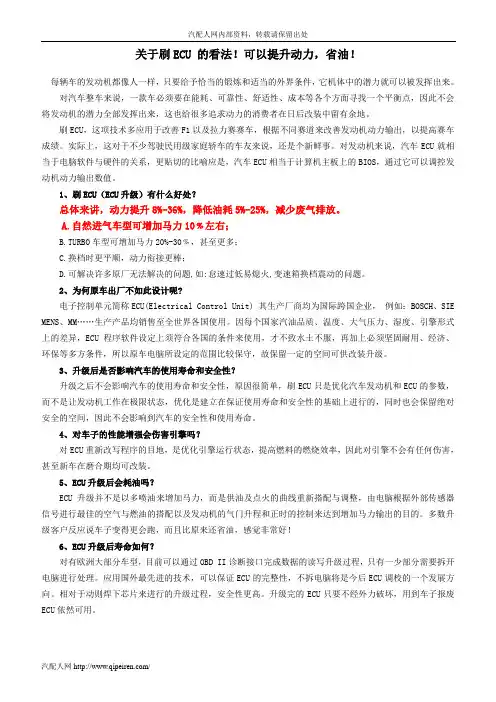
关于刷ECU 的看法!可以提升动力,省油!每辆车的发动机都像人一样,只要给予恰当的锻炼和适当的外界条件,它机体中的潜力就可以被发挥出来。
对汽车整车来说,一款车必须要在能耗、可靠性、舒适性、成本等各个方面寻找一个平衡点,因此不会将发动机的潜力全部发挥出来,这也给很多追求动力的消费者在日后改装中留有余地。
刷ECU,这项技术多应用于改善F1以及拉力赛赛车,根据不同赛道来改善发动机动力输出,以提高赛车成绩。
实际上,这对于不少驾驶民用级家庭轿车的车友来说,还是个新鲜事。
对发动机来说,汽车ECU就相当于电脑软件与硬件的关系,更贴切的比喻应是,汽车ECU相当于计算机主板上的BIOS,通过它可以调控发动机动力输出数值。
1、刷ECU(ECU升级)有什么好处?总体来讲,动力提升8%-36%,降低油耗5%-25%,减少废气排放。
A.自然进气车型可增加马力10﹪左右;B.TURBO车型可增加马力20%-30﹪,甚至更多;C.换档时更平顺,动力衔接更棒;D.可解决许多原厂无法解决的问题,如:怠速过低易熄火,变速箱换档震动的问题。
2、为何原车出厂不如此设计呢?电子控制单元简称ECU(Electrical Control Unit) 其生产厂商均为国际跨国企业,例如:BOSCH、SIE MENS、MM……生产产品均销售至全世界各国使用。
因每个国家汽油品质、温度、大气压力、湿度、引擎形式上的差异,ECU程序软件设定上须符合各国的条件来使用,才不致水土不服,再加上必须坚固耐用、经济、环保等多方条件,所以原车电脑所设定的范围比较保守,故保留一定的空间可供改装升级。
3、升级后是否影响汽车的使用寿命和安全性?升级之后不会影响汽车的使用寿命和安全性,原因很简单,刷ECU只是优化汽车发动机和ECU的参数,而不是让发动机工作在极限状态,优化是建立在保证使用寿命和安全性的基础上进行的,同时也会保留绝对安全的空间,因此不会影响到汽车的安全性和使用寿命。
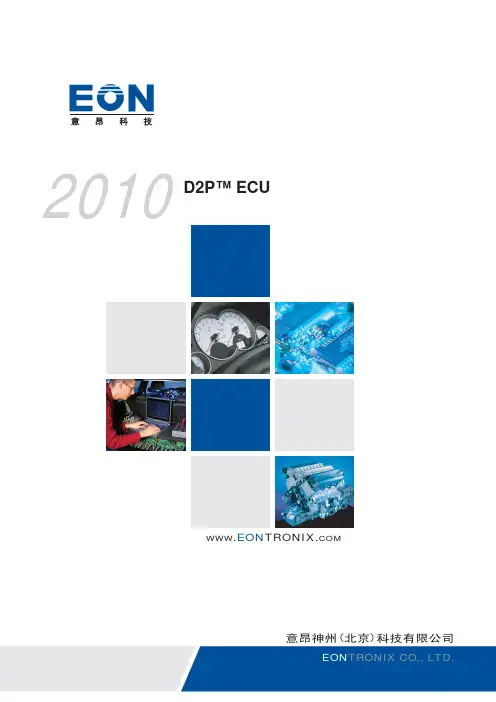

汽车ecu硬件开发流程英文回答:Automotive ECU Hardware Development Process.The automotive ECU hardware development process is a complex and multifaceted undertaking that requires a high level of expertise and coordination. The process typically begins with the definition of the ECU requirements, which are then used to develop a system architecture and hardware design. Once the hardware design is complete, the ECU is prototyped and tested to ensure that it meets the required specifications.The following are the key steps in the automotive ECU hardware development process:1. Requirements Definition.The first step in the ECU hardware development processis to define the requirements for the ECU. These requirements should include the following:Functional requirements: These requirements define the functionality that the ECU must provide.Performance requirements: These requirements define the performance that the ECU must achieve, such as its processing speed, memory capacity, and I/O capabilities.Environmental requirements: These requirements define the environmental conditions that the ECU must be able to withstand, such as temperature, humidity, and vibration.2. System Architecture Development.Once the ECU requirements have been defined, the next step is to develop a system architecture for the ECU. The system architecture defines the overall structure of the ECU, including the following:The number and type of microcontrollers.The memory and I/O devices.The communication interfaces.The power supply.3. Hardware Design.Once the system architecture has been developed, the next step is to design the ECU hardware. The hardware design includes the following:The schematic design: The schematic design defines the electrical connections between the different components of the ECU.The printed circuit board (PCB) design: The PCB design defines the physical layout of the ECU's components.The component selection: The component selection process involves selecting the specific components thatwill be used in the ECU.4. Prototyping.Once the hardware design is complete, the next step is to prototype the ECU. The prototype is a physical representation of the ECU that is used to test the ECU's functionality and performance.5. Testing.Once the prototype has been built, the next step is to test the ECU. The testing process includes the following:Functional testing: Functional testing verifies that the ECU meets its functional requirements.Performance testing: Performance testing verifies that the ECU meets its performance requirements.Environmental testing: Environmental testing verifies that the ECU meets its environmental requirements.6. Production.Once the ECU has been tested and verified, the next step is to produce the ECU. The production process involves manufacturing the ECU's components, assembling the ECU, and testing the finished ECU.中文回答:汽车 ECU 硬件开发流程。
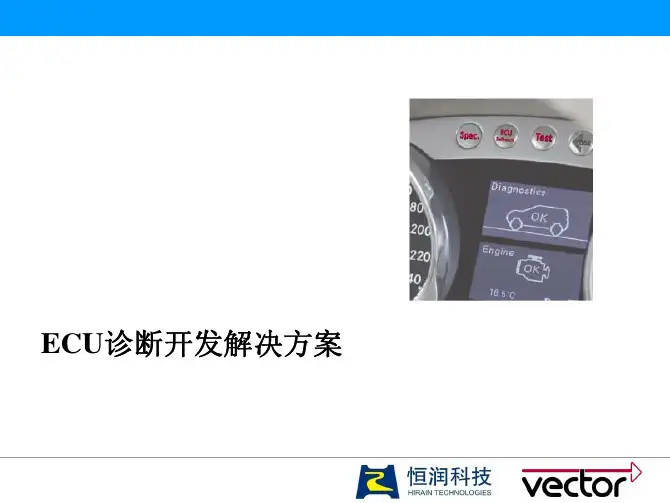
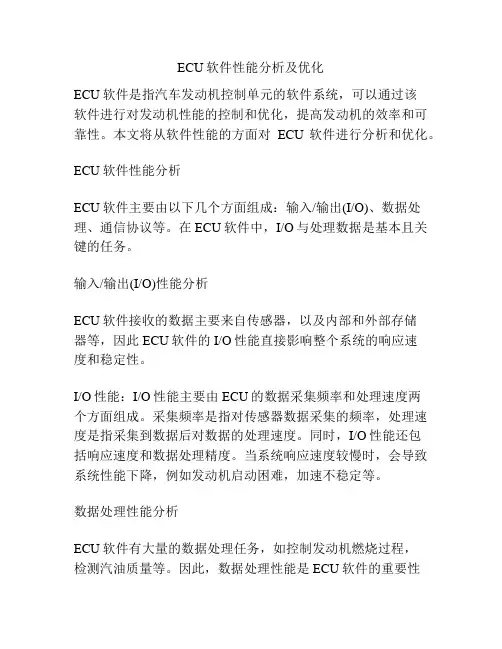
ECU软件性能分析及优化ECU软件是指汽车发动机控制单元的软件系统,可以通过该软件进行对发动机性能的控制和优化,提高发动机的效率和可靠性。
本文将从软件性能的方面对ECU软件进行分析和优化。
ECU软件性能分析ECU软件主要由以下几个方面组成:输入/输出(I/O)、数据处理、通信协议等。
在ECU软件中,I/O与处理数据是基本且关键的任务。
输入/输出(I/O)性能分析ECU软件接收的数据主要来自传感器,以及内部和外部存储器等,因此ECU软件的I/O性能直接影响整个系统的响应速度和稳定性。
I/O性能:I/O性能主要由ECU的数据采集频率和处理速度两个方面组成。
采集频率是指对传感器数据采集的频率,处理速度是指采集到数据后对数据的处理速度。
同时,I/O性能还包括响应速度和数据处理精度。
当系统响应速度较慢时,会导致系统性能下降,例如发动机启动困难,加速不稳定等。
数据处理性能分析ECU软件有大量的数据处理任务,如控制发动机燃烧过程,检测汽油质量等。
因此,数据处理性能是ECU软件的重要性能指标之一。
数据处理速度:ECU软件处理数据的速度和响应能力决定了整个系统的性能。
由于数据处理任务较多而且十分复杂,因此在ECU软件中需要合理规划和引入高效的算法来提高处理速度和准确度。
内存使用:ECU软件是一个较大的应用程序,需要使用大量的内存空间。
因此,合理的内存使用是提高数据处理速度和准确性的关键。
如果ECU软件过度依赖内存,可能会导致系统崩溃或其他性能问题。
通信协议性能分析通信协议是ECU软件的重要组成部分,主要控制电机与其他设备之间的数据传输。
通信协议性能包括通信速度和可靠性等方面。
通信速度:通信速度决定了ECU软件与其他设备之间数据传输的速率。
较慢的通信速度会导致数据传输不完整或延迟,从而影响整个系统的性能。
通信可靠性:通信可靠性是ECU软件保证数据传输的成功率和数据准确度的关键。
因此,在设计通信协议时,需要考虑到数据帧、数据校验和消息确认等方面。
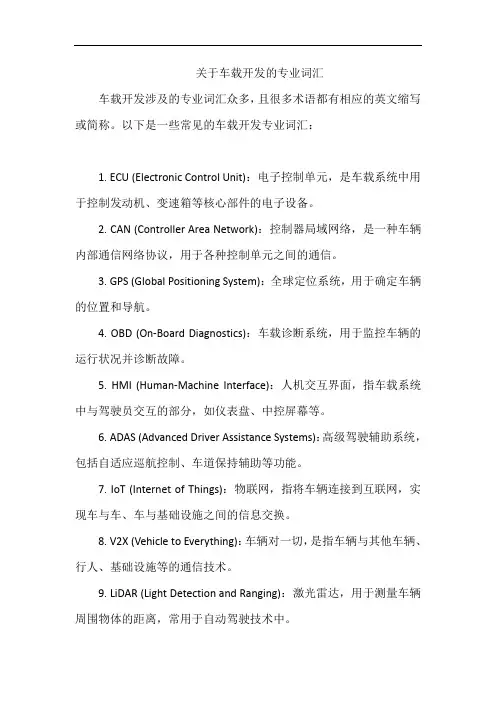
关于车载开发的专业词汇车载开发涉及的专业词汇众多,且很多术语都有相应的英文缩写或简称。
以下是一些常见的车载开发专业词汇:1. ECU (Electronic Control Unit):电子控制单元,是车载系统中用于控制发动机、变速箱等核心部件的电子设备。
2. CAN (Controller Area Network):控制器局域网络,是一种车辆内部通信网络协议,用于各种控制单元之间的通信。
3. GPS (Global Positioning System):全球定位系统,用于确定车辆的位置和导航。
4. OBD (On-Board Diagnostics):车载诊断系统,用于监控车辆的运行状况并诊断故障。
5. HMI (Human-Machine Interface):人机交互界面,指车载系统中与驾驶员交互的部分,如仪表盘、中控屏幕等。
6. ADAS (Advanced Driver Assistance Systems):高级驾驶辅助系统,包括自适应巡航控制、车道保持辅助等功能。
7. IoT (Internet of Things):物联网,指将车辆连接到互联网,实现车与车、车与基础设施之间的信息交换。
8. V2X (Vehicle to Everything):车辆对一切,是指车辆与其他车辆、行人、基础设施等的通信技术。
9. LiDAR (Light Detection and Ranging):激光雷达,用于测量车辆周围物体的距离,常用于自动驾驶技术中。
10. UI (User Interface):用户界面,指车载系统中供用户操作的界面设计。
11. UX (User Experience):用户体验,指用户在使用车载系统时的感受和体验。
12. API (Application Programming Interface):应用程序编程接口,用于车载系统中不同软件组件之间的通信。
13. SDK (Software Development Kit):软件开发工具包,提供给开发者用于创建车载应用的工具集。
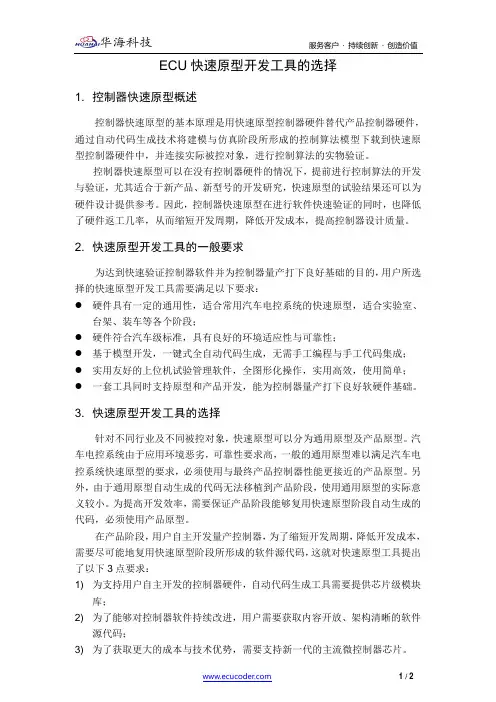
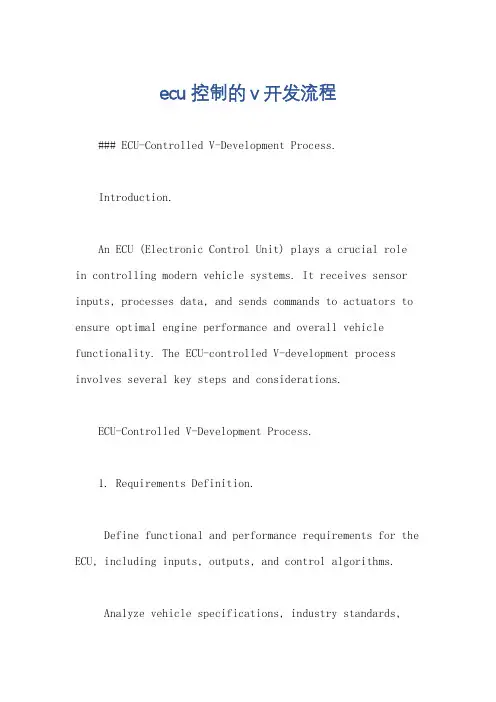
ecu控制的v开发流程### ECU-Controlled V-Development Process.Introduction.An ECU (Electronic Control Unit) plays a crucial role in controlling modern vehicle systems. It receives sensor inputs, processes data, and sends commands to actuators to ensure optimal engine performance and overall vehicle functionality. The ECU-controlled V-development process involves several key steps and considerations.ECU-Controlled V-Development Process.1. Requirements Definition.Define functional and performance requirements for the ECU, including inputs, outputs, and control algorithms.Analyze vehicle specifications, industry standards,and customer needs.2. ECU Design.Select appropriate hardware and software componentsfor the ECU.Design ECU architecture, including input/output interfaces, signal processing algorithms, and control logic.Develop ECU firmware and software modules.3. Testing and Validation.Conduct unit testing and integration testing to verify ECU functionality.Perform hardware-in-the-loop (HIL) and software-in-the-loop (SIL) testing.Validate ECU performance on a test vehicle or test bench.4. Calibration and Tuning.Adjust ECU parameters and control algorithms to optimize performance.Use data logging and analysis to fine-tune ECU behavior.Iterate through testing and calibration phases to ensure optimal ECU operation.5. Integration and Deployment.Integrate ECU into the vehicle system and connect necessary inputs/outputs.Test ECU functionality in combination with other vehicle components.Deploy the ECU in production vehicles and monitor its performance.Considerations.ECU Hardware Selection: Consider processing power, memory capacity, and input/output capabilities required.Software Development: Use industry-standard coding practices and follow software development lifecycle methodologies.Testing and Validation: Ensure thorough testing at all levels to guarantee ECU reliability and performance.Calibration and Tuning: Involve experts with deep understanding of vehicle dynamics and ECU control.Integration and Deployment: Collaborate with vehicle system engineers and ensure proper ECU integration and testing.### ECU 控制的 V 开发流程。
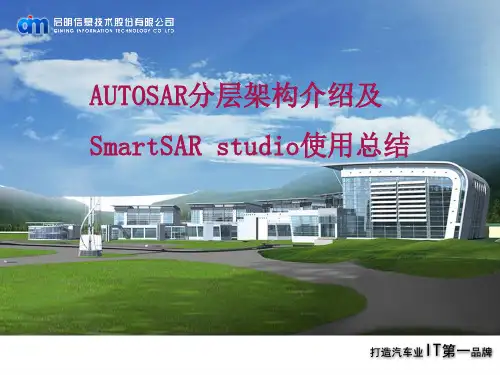
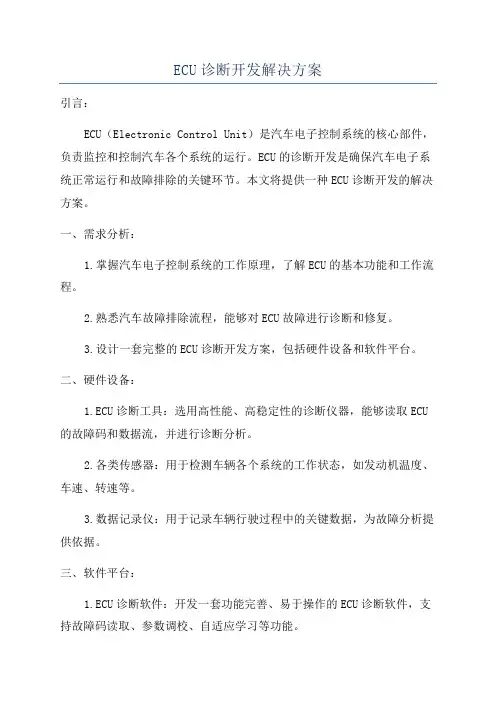
ECU诊断开发解决方案引言:ECU(Electronic Control Unit)是汽车电子控制系统的核心部件,负责监控和控制汽车各个系统的运行。
ECU的诊断开发是确保汽车电子系统正常运行和故障排除的关键环节。
本文将提供一种ECU诊断开发的解决方案。
一、需求分析:1.掌握汽车电子控制系统的工作原理,了解ECU的基本功能和工作流程。
2.熟悉汽车故障排除流程,能够对ECU故障进行诊断和修复。
3.设计一套完整的ECU诊断开发方案,包括硬件设备和软件平台。
二、硬件设备:1.ECU诊断工具:选用高性能、高稳定性的诊断仪器,能够读取ECU 的故障码和数据流,并进行诊断分析。
2.各类传感器:用于检测车辆各个系统的工作状态,如发动机温度、车速、转速等。
3.数据记录仪:用于记录车辆行驶过程中的关键数据,为故障分析提供依据。
三、软件平台:1.ECU诊断软件:开发一套功能完善、易于操作的ECU诊断软件,支持故障码读取、参数调校、自适应学习等功能。
2.数据分析工具:提供数据分析功能,对车辆行驶数据进行处理和分析,发现潜在的故障问题。
3.故障库管理系统:建立一套完整的故障库,包括常见故障的描述、解决方案和修复记录,以便开发人员快速定位和解决问题。
四、开发流程:1.ECU固件开发:根据汽车品牌和型号的要求,进行ECU固件的开发和优化,确保ECU的正常工作和稳定性。
2.ECU诊断功能开发:根据汽车厂家提供的诊断要求,开发相应的诊断功能,包括故障码读取、参数调校等。
3.ECU诊断软件开发:基于已有的开源软件平台开发ECU诊断软件,提供友好的用户界面和全面的诊断功能。
4.故障数据收集和分析:通过数据记录仪收集车辆行驶数据,并进行分析,发现潜在的故障问题。
5.故障库管理更新:将发现的故障问题整理成故障库,包括问题描述、解决方案和修复记录,以便开发人员快速定位和解决问题。
五、实施与测试:1.ECU固件升级:将开发好的ECU固件烧录到车辆的ECU中,进行实际的功能测试和性能评估。
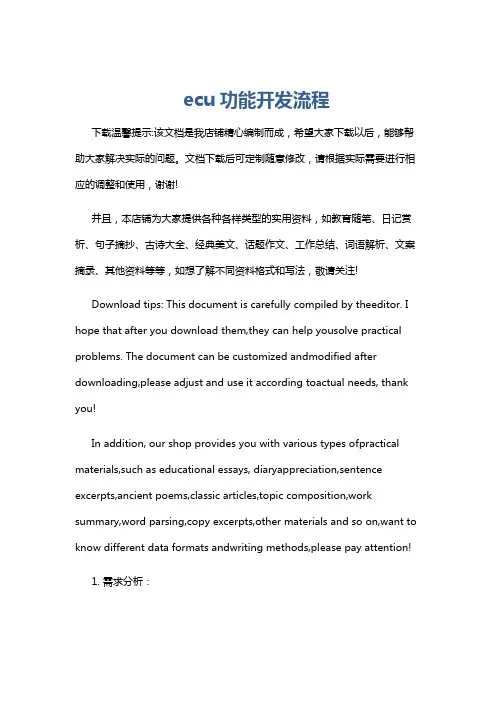
ecu功能开发流程下载温馨提示:该文档是我店铺精心编制而成,希望大家下载以后,能够帮助大家解决实际的问题。
文档下载后可定制随意修改,请根据实际需要进行相应的调整和使用,谢谢!并且,本店铺为大家提供各种各样类型的实用资料,如教育随笔、日记赏析、句子摘抄、古诗大全、经典美文、话题作文、工作总结、词语解析、文案摘录、其他资料等等,如想了解不同资料格式和写法,敬请关注!Download tips: This document is carefully compiled by theeditor. I hope that after you download them,they can help yousolve practical problems. The document can be customized andmodified after downloading,please adjust and use it according toactual needs, thank you!In addition, our shop provides you with various types ofpractical materials,such as educational essays, diaryappreciation,sentence excerpts,ancient poems,classic articles,topic composition,work summary,word parsing,copy excerpts,other materials and so on,want to know different data formats andwriting methods,please pay attention!1. 需求分析:与项目团队、客户或相关利益者沟通,了解 ECU 所需实现的功能和性能要求。
一、基本流程基于V模型的电子电气架构测试的基本流程如下图所示:图1 基本测试流程测试需求分析:整理相关产品的测试需求,通过确定需要测试的内容和范围,进一步确定测试过程中如工具、人员等资源;测试计划制定:通过需求分析的结果,根据整车开发节点、相关产品的软硬件成熟度制定合适的测试方案。
计划一般包括:团队成员具体分工、完整并合理的测试时间节点、测试环境配置、完善的测试范围以及测试验收的标准等内容。
测试用例:基于白盒、黑盒或专家经验进行测试用例的设计,通过设置不同条件、拓扑、步骤和期望结果对电子电气架构中对于各控制器在‘测试计划’中定义的如基础通讯、诊断、刷写和功能等诸多方面内容进行测试;实施测试:通过使用相关测试工具对测试用例的使用并搭建测试环境台架对单节点/子系统或系统进行测试;报告输出:针对每一条测试用例的测试结果进行分析,并形成测试报告。
对测试过程中的问题点通过对测试内容描述、测试条件、测试环境、操作步骤以及现象以文字、照片等方式进行记录,形成问题清单;结果分析:对测试报告中的问题点进行分析,以定位测试问题是由软件、硬件或是测试用例、测试步骤还是测试条件等原因造成的,以形成二轮测试整个方案;回归测试:对整改问题按照方案进行逐一再次测试,形成二轮测试报告,直到问题的关闭;测试总结:通过统计测试用例执行的数量、发现的问题、项目执行时间等相关数据,并以测试计划中所规定的测试范围、时间、验收标准为基准对测试结果进行评估,以总结本次测试工作的执行结果,并证明该项目已经达到了测试计划及需求中所期望的内容和质量要求。
二、EEA开发测试工具链在电子电气架构的开发测试过程中其所用的工具链种类繁多,现对不同阶段下所使用的主流工具链中的部分整理如下:需求分析:EA(UML 建模工具)、Rhapsody(建模工具),DOORS(需求管理工具)、Reqtify(需求管理工具)、SystemWeaver(电子电气协同研发工具)、PREEvision(电子电气协同研发工具))、pure:variants(产品线变体管理工具)、IBM Rational Team Concert (RTC)(软件协作开发管理)、ReqMan(需求提取和协同处理工具)、Stimulus(需求形式化建模和分析工具);系统设计:PREEvison、Rhapsody(MBSE 开发工具)、MagicDraw(系统设计分析工具)、symtavision(分布式控制系统时间建模分析和验证工具)功能设计:SystemWeaver、PREEvision、DaVinci Developer(Autosar ECU 软件开发图形配置工具)、EA;模型设计:Altia(基于模型的嵌入式HMI 开发)、VAPS-XT(HMI 建模仿真工具)、GL studio(HMI 开发仿真工具)、Eggplant(HMI 自动化测试);功能安全:Medini analyze(功能安全、预期功能安全、信息安全开发平台);工具认证:SuperTest、SuperGuard(为自研或未经认证的工具进行认证);仿真开发:自动驾驶仿真软件:Prescan、carsim、Carla、LGSVL、Simlation Lifecycle Management(SLM)(仿真过程与数据管理平台)、DYNA4(发动机及车辆实时仿真模型开发)、VTD(场景仿真)数据采集与分析:ViCANdo;系统开发和配置:DaVinci Developer、DaVinci Configurator Pro(Autosar 基础软件模块配置、验证和生成工具)、Simulink(可视化仿真工具);代码生成:DaVinci Developer、Simulink、TargetLink(目标代码生成工具)、SimuQuest (车用ECU常用微处理器的硬件驱动模型库);系统调试:CANoe(汽车总线开发测试工具)、VNC Automotive(手机车机互联);电气开发:CATIA(CAD/CAE/CAM 建模软件)、CHS(汽车线束设计开发工具)、AUTOCAD (绘图工具)、SaberRD(电子电气系统仿真建模工具)、Capital(电气系统和线束设计工具)、Mentor Graphics(电子设计自动化工具);基于C/C++的传统ECU软件测试:LDRA、RVS(软件性能测试工具)、C/C++test(C/C++自动化测试工具)、Mx Suite(嵌入式软件一体测试平台)、QAC(静态代码测试工具)、Tessy(单元/集成测试工具);基于智驾/座舱系统级大型软件测试:Black Duck(软件组成分析)、Coverity(静态分析)、Defensics(模糊测试);CAN/LIN通信架构开发:CANoe、Pcan、zlgCan;CAN/LIN测试:CANoe、CANscope、CANstress、CANlog、Q-Automation;以太网开发:PREEvision、EA、RTaW、Systemweaver;以太网测试:CANoe、Spirent Testcenter C50-100G、1000BASE-T1与100/1000BASE-TX 双向转换器、Media Gateway、100/1000BASE-T1 SPY 、Capture Module 、GoldenDevice、OptoLyzer Studio、MOCCA、IPETRONIK、Spirent;EEA架构测试仿真验证(MIL 、SIL 、HIL、VIL):MIL:Simulink,SIL:dSPACE VEOS、Silver、VDK、Veristand、VectorCAST、CTC++、ETAS 套件,HIL&VIL:Vector VT 测试系统、dSPACE HIL 测试系统、NI HIL测试系统;EEA架构测试仿真验证(SOA 软件测试):CANoe、vTESTstudio、PARASOFT SOAtest (需二次开发);参数标定:参数标定CANape、INCA、VISION(控制器标定及网络分析);ECU 集成开发:DaVinci Developer、XCP(集成工具包);CI/CD 系统持续集成、持续交付和持续部署工具:Systemweaver、Gitee(源代码管理工具)、Jenkins(系统集成工具)、JIRA(项目管理工具)、Confluence(项目管理工具);OTA 诊断及刷写:CANoe 、vTESTstudio 、vConnect 、CANdelaStudio 、CANoe.DiVa。
£技朮交*Technical Communication基于ECU-TEST的ECU诊断工具API接口自动化测试应用邵金萍(潍柴动力股份有限公司,山东潍坊261061)摘要:ECU-TEST是一种内嵌Python脚本语言的ECU自动化测试软件;ECU诊断工具是一种基于Visual Studio平台C#语言开发的ECU诊断测试应用程序,能够实现读取ECU中版本信息%故障码信息及进行参数标定等功能&本文基于ECU-TEST编写Python脚本,调用ECU诊断工具.dll文件中的API命令,实现了诊断工具软件升级过程中的自动化测试,保证了诊断工具开发的准确性,提高了测试效率&关键词:ECU;诊断工具;自动化测试;Python;.dll;C#中图分类号:U463.6文献标志码:A文章编号:1003-8639(2020)05-0075-03The Automatic Test Application of ECU Diagnostic Tool API Based on ECU-TEST SoftwareSHAO Jin-ping(Weichai Power Co.#Ltd.#Weifang261061#China)Abstract:ECU-TEST is one kind of ECU automatic test software with built-in script language Python;ECU diagnostic tool is one kind of application software for ECU diagnostic test,which is developed by C#on the strength of Visual Studio platform;with ECU diagnostic tool,it can realize to read and write ECU program version information,diagnostic fault coding information,calibrate parameters and so on.The paper introduces serials of Python scripts compiled in ECU-TEST to call API instruction set in.dll files.This solution can be used to automatically test ECU diagnostic tool for version upgrade during developing phases so as to improve software accuracy and test efficiency.Key words:ECU;diagnostic tool;automatic test;Python;.dll;C#邵金萍(1984-),女,工程师,硕士,主要从事内燃机电控测试工作及研究。
汽车电子控制单元ECU设计与开发汽车电子控制单元(ECU)设计与开发随着科技的不断进步,汽车电子控制单元(ECU)在汽车行业中扮演着至关重要的角色。
ECU是汽车电子系统的核心,负责监控和控制车辆的各种功能,如引擎控制、制动系统控制、安全控制和驾驶辅助系统控制等。
本文将探讨汽车ECU的设计与开发过程,旨在让读者了解ECU的基本原理以及设计开发过程中的一些关键要素。
一、ECU的基本工作原理汽车ECU是一种用于控制车辆功能和运行的微型计算机系统。
它通常由处理器、储存器、输入/输出接口和各种传感器组成。
ECU的主要工作原理是通过读取传感器所采集的车辆数据信息,并根据预定义的算法和程序进行处理和决策,最终控制相应的车辆功能。
二、ECU设计与开发的关键要素1. 硬件设计ECU的硬件设计是整个开发过程中的重要一环。
它需要考虑到汽车电子系统的特点,如高温、振动等环境因素的影响。
硬件设计师需要选择适合的元器件和电路设计方案,并进行可靠性验证和性能测试,以确保ECU能够在各种复杂条件下正常工作。
2. 软件开发ECU的软件开发是实现各种功能和逻辑的关键。
开发人员需根据车辆的功能需求和设计要求,编写嵌入式软件程序。
这包括算法的设计与开发、硬件驱动的编写、故障检测和诊断功能的实现等。
软件开发过程需要经过严格的测试和验证,以确保ECU能够稳定可靠地工作。
3. 通信协议由于车辆内部的各个电子控制单元之间需要进行信息交换和协作,通信协议的设计是ECU开发中的重要一环。
常见的通信协议包括CAN (Controller Area Network)总线、LIN(Local Interconnect Network)总线等。
根据车辆系统的需求和通信速率的要求,选择合适的通信协议是确保ECU正常工作的关键。
4. 故障检测与诊断为了确保车辆的安全性和可靠性,ECU需要具备故障检测和诊断功能。
开发人员需要编写相应的软件程序来监测和检测车辆系统中的故障,并提供相应的警报和诊断信息。
ECU标定开发解决方案ECU(发动机控制单元)标定开发是指针对汽车发动机控制系统的标定参数进行调试和优化的过程。
标定参数的准确性和优化程度直接影响到发动机的性能、燃油经济性和排放水平等关键指标。
因此,ECU标定开发是汽车行业中极为重要的一项工作。
针对ECU标定开发,以下是一个解决方案的详细说明,包括标定步骤、技术工具和方法等方面。
1.确定标定目标:在ECU标定开发的初期,需要明确定义标定目标,包括性能提升、燃油经济性改进、排放控制等方面。
这样可以明确标定的方向和重点,为后续的工作提供指导。
2.收集测试数据:ECU标定开发需要大量的测试数据作为依据。
这些数据可以通过实车测试、模拟测试、测试台等手段进行收集。
收集到的数据应包括不同工况下的车速、转速、负荷、油耗、排放等参数。
3.数据处理与分析:通过数据处理与分析,可以对收集到的测试数据进行分析和挖掘,找出存在的问题和不足之处。
这有助于确定标定参数的优化方向。
4.参数标定和优化:在标定前,需要对发动机模型进行建立,包括喷射系统、气缸压力、传感器响应等模块。
然后根据标定目标,通过调整和优化标定参数,如喷油量、点火时机、进气门相位等,来实现性能的提升和优化。
5.标定验证和优化:在进行标定后,需要对标定结果进行验证和优化。
这可以通过实车测试或模拟仿真测试等手段来完成。
并根据测试结果进行反复调整和优化,直到达到预期的效果。
在标定过程中,也需要考虑到不同地域和使用条件对标定参数的适应性。
在ECU标定开发中,还需要使用各种专业的工具和软件来辅助完成工作。
1.数据采集和分析软件:ECU标定需要大量的数据支持,因此需要使用数据采集和分析软件来对测试数据进行处理、分析和挖掘。
2.标定工具和工作台:标定工具和工作台用于实现参数的调整和优化,包括座椅式工作台、标定软件、连接线缆等。
3.模拟仿真软件:模拟仿真软件可以在标定过程中进行快速的试验和测试,减少实际测试的时间和成本。
ECU系统开发工具链
ECU System Development Tool Chain
alen-eyre@
ECU 开发V模型 ECU V Model
1
CRManager
2
Excel2DBC
3
CodeFormatter
4
A2L Compare
9 LabelManager
10 TimeLineCalc
5 INCA Add-on
6 AutoCalSystem
7 DataAnalyzer
8 DCM Compare
工具链 Tool Chain
编号No. 名称
Name
描述
Description
1 CRManager 基于数据库的需求管理
Change requirement management based on database
2 Excel2DBC CAN DBC生成
Create CAN DBC from Excel
3 CodeFormatter 自动代码格式化
Standardize code format
4 A2L Compare A2L模块和系统常数管理
A2L function and system constant managment
5 INCA Add-on INCA实验环境插件:INCAEnum、INCAMask、INCABitCal
INCA Experiment Add-on:INCAEnum、INCAMask、INCABitCal 6 AutoCalSystem 自动测量标定系统
Automatic calibration system
编号No. 名称
Name
描述
Description
7 DataAnalzyer 数据分析:dat、asc等格式
Analyze data, support dat\asc format
8 DCM Compare 基于Excel的标定数据管理
Calibration data management based on Excel
9 LabelManager 基于数据库的标定数据管理
Calibration data management based on database 10 TimeLineCalc 时间节点计算
Time line calculate
关键技术 Key Feature
⏹常用工具的二次开发,如INCA、PUMA、CAMEO、CANalzyer。
Secondary development for common tool, such as INCA, PUMA, CAMEO, CANalyzer.
⏹常用数据格式的处理,如a2l、hex、dcm、dat、asc等。
Handle common format data, such as a2l, hex, dcm, dat, asc.
⏹既有基于Excel VBA的便携工具,又有基于数据库的复杂系统。
Not only have portable tool by Excel VBA, but also have complex system by database.
Thanks for watching
Please contact alen-eyre@ for more information。